SEO moves fast. What worked yesterday might fall short today. As a marketing agency, you need to know exactly what to measure to prove your worth and drive your clients’ success. Once you have a solid grasp on these key SEO metrics, you’ll be well-equipped to track your SEO progress effectively and craft compelling reports that showcase the value of your SEO efforts.
We’re not just listing metrics; we’re showing how to turn these into real, tangible results for your clients. Each metric ties directly to business outcomes—no fluff, no vanity metrics.
Top 10 Most Important SEO Metrics (Based on Data)
Before diving in, we want to share insights gathered from surveying thousands of agencies to understand the key metrics they report. These insights reflect the metrics most commonly prioritized and tracked across the industry.
However, instead of simply discussing these popular metrics, we challenge you to focus on deeper, more meaningful ones that go beyond the norm. While some of the metrics align with industry standards, others are chosen for their emphasis on quality over quantity, offering insights that drive real client success.
Top 10 Most Important SEO Metrics (According to the Article)
What’s So Important About These SEO Metrics?
Why these metrics? Simple. They show the true impact of your work on your clients’ bottom line. From traffic quality to ROI calculations, each one packs a punch in demonstrating value and shaping strategy.
But here’s the kicker: we’re not just telling you what to watch. We’re arming you with the know-how to act on these metrics. You’ll learn how to make smart decisions, fine-tune your strategies, and clearly communicate your value to clients.
What sets this guide apart? We get it. You’re juggling multiple clients, each with their own goals and challenges. That’s why we’ve focused on metrics that matter across the board. But we also show you how to tailor your approach for each unique situation.
Are we missing anything? Maybe. SEO is a big field. Depending on your clients, you might also want to keep an eye on:
- Brand visibility scores
- Local SEO performance
- Content engagement stats
- E-commerce metrics like revenue per visit
- Voice search optimization data
You don’t need to track everything under the sun. Focus on the metrics that align with your clients’ goals. Use this guide as your starting point, then customize based on what each client really needs.
From Metrics to Meaningful KPIs
Before we get to the top 10 SEO metrics, let’s clarify something super important: the difference between metrics and KPIs. This isn’t just semantics; it’s the key to proving the tangible value of your SEO efforts.
Metrics are raw measurements. Think of them as the building blocks of your SEO reporting. Click-through rates, bounce rates, keyword rankings – these are all metrics. They give you a wealth of data points to analyze.
But metrics alone don’t tell the whole story. That’s where KPIs come in. KPIs are strategic metrics that are directly tied to specific business objectives. They take raw SEO data and make it meaningful in the context of your client’s goals.
Let’s look at an example. Organic traffic is a metric. It tells you how many people are finding your client’s site through organic search. But a KPI would be the percentage of that organic traffic that converts into leads or sales. That KPI directly connects SEO performance to business results.
Or consider keyword rankings. Ranking #1 for a keyword is a metric to celebrate, right? But what if that keyword brings in tons of traffic but no conversions? A more meaningful KPI would be the estimated revenue impact from improved rankings for carefully selected, high-intent keywords.
Your goal for your client isn’t just to move metrics, but to move the metrics that matter. That’s why it’s crucial to work with your clients to understand their specific goals. What needle do they want to move? Is it lead generation, online sales, brand awareness? Taillor your SEO KPIs around those objectives.
Once you’ve defined your KPIs, they should be the north star of your SEO reporting and analysis. Don’t just report the numbers; provide insights and recommendations based on KPI performance. If a KPI is underperforming, dive into the why and propose solutions. If a KPI is excelling, analyze what’s working and how you can replicate that success.
It’s not about how much data an SEO report has. KPIs help show your SEO work actually pays off.
When looking at the top 10 SEO metrics, always keep these key performance indicators in mind. These metrics are great on their own, but they’re even better when linked to your main goals. Let’s see how you can use these metrics to get real results for your clients’ businesses.
Ready to dive in? Let’s get to the SEO metrics to track that will truly move the needle for your agency and your clients.
Top 10 SEO Metrics Your Clients Care About
Impact on Client’s Business: Directly impacts visibility and potential conversions
Tools for Measurement: Google Analytics, Swydo, GA4
Recommended Action Steps: Focus on high-value keywords, optimize top landing pages
Common Pitfalls: Focusing only on traffic volume without considering traffic quality
Advanced Tips: Segment traffic by user intent and track the impact on conversions
Client Communication Strategy: Showcase year-over-year growth in organic traffic and highlight quality improvements
Impact on Client’s Business: Measures the effectiveness of attracting the right audience
Tools for Measurement: Google Analytics, Custom Metrics
Recommended Action Steps: Optimize user experience, A/B test landing pages
Common Pitfalls: Ignoring micro-conversions that signal user intent
Advanced Tips: Use heatmaps to understand user behavior and make data-driven changes
Client Communication Strategy: Explain how conversion rate improvements directly impact revenue
Impact on Client’s Business: Shows visibility for strategic search terms
Tools for Measurement: SEMrush, SE Ranking
Recommended Action Steps: Track a mix of short-tail and long-tail keywords
Common Pitfalls: Chasing #1 rankings for all keywords instead of focusing on high-value terms
Advanced Tips: Prioritize ranking improvements for keywords that drive conversions
Client Communication Strategy: Relate keyword ranking changes to shifts in organic traffic and conversions
Impact on Client’s Business: Critical for user experience and conversions
Tools for Measurement: Google PageSpeed Insights, Pingdom
Recommended Action Steps: Optimize images, minify CSS and JavaScript files
Common Pitfalls: Neglecting mobile page speed, which is now prioritized by Google
Advanced Tips: Use lazy loading for images and asynchronous loading for scripts
Client Communication Strategy: Demonstrate how speed improvements lead to better user engagement and higher conversions
Impact on Client’s Business: Indicates the effectiveness of search listings
Tools for Measurement: Google Search Console
Recommended Action Steps: Optimize titles and meta descriptions, use structured data
Common Pitfalls: Overlooking the importance of meta description optimization
Advanced Tips: Test different meta descriptions to find the most compelling versions
Client Communication Strategy: Show how CTR improvements correlate with increased traffic and engagement
Impact on Client’s Business: Signals trust and authority to search engines
Tools for Measurement: SEMrush, Majestic
Recommended Action Steps: Prioritize high-quality, relevant backlinks over quantity
Common Pitfalls: Focusing solely on the number of backlinks rather than their quality
Advanced Tips: Build relationships with industry influencers for natural link-building
Client Communication Strategy: Explain how quality backlinks enhance site authority and improve rankings
Impact on Client’s Business: Provides a snapshot of overall SEO health
Tools for Measurement: Moz, Ahrefs, SEMrush
Recommended Action Steps: Focus on long-term improvement through quality content and backlinks
Common Pitfalls: Obsessing over small fluctuations in DA or DR instead of focusing on overall growth
Advanced Tips: Benchmark against competitors and set realistic goals for improvement
Client Communication Strategy: Use DA/DR to set client expectations about ranking potential
Impact on Client’s Business: Crucial due to mobile-first indexing
Tools for Measurement: Google Analytics, Swydo
Recommended Action Steps: Ensure mobile optimization of content and UX
Common Pitfalls: Assuming a responsive design is sufficient without testing mobile-specific issues
Advanced Tips: Test mobile UX regularly and optimize for speed and readability
Client Communication Strategy: Highlight the growing importance of mobile traffic and how it relates to conversions
Impact on Client’s Business: Indicates content relevance and user engagement
Tools for Measurement: Google Analytics, Hotjar
Recommended Action Steps: Optimize content to better match user intent
Common Pitfalls: Misinterpreting high bounce rates without considering content type and intent
Advanced Tips: Use heatmaps to identify and fix issues with high-bounce pages
Client Communication Strategy: Explain when a high bounce rate is acceptable (e.g., blog posts) and when it’s not (e.g., product pages)
Impact on Client’s Business: Directly ties SEO efforts to client’s bottom line
Tools for Measurement: Custom Calculation, Google Analytics
Recommended Action Steps: Use multi-touch attribution to accurately measure SEO’s impact
Common Pitfalls: Relying solely on last-click attribution models
Advanced Tips: Track and report on SEO ROI over long-term periods for a more accurate reflection of its value
Client Communication Strategy: Regularly report ROI in financial terms to demonstrate the true value of your SEO work
1. Organic Traffic
This is what I look at as soon as I wake up and before I have my coffee. Organic traffic is the lifeblood of SEO success. It’s not just a numbers game; it’s about attracting quality visitors who are likely to engage with your client’s content and convert.
Dive deep into your organic traffic data. Which pages pull in the most visitors? What keywords lead them to your site? How do these visitors behave once they arrive? These insights will sharpen your SEO strategy, focusing your efforts on attracting high-value traffic.
Raw traffic numbers don’t tell the whole story. A 20% increase in organic traffic sounds good, but what if it led to a 50% boost in qualified leads? That’s the kind of insight that will grab your clients’ attention and prove your SEO value.
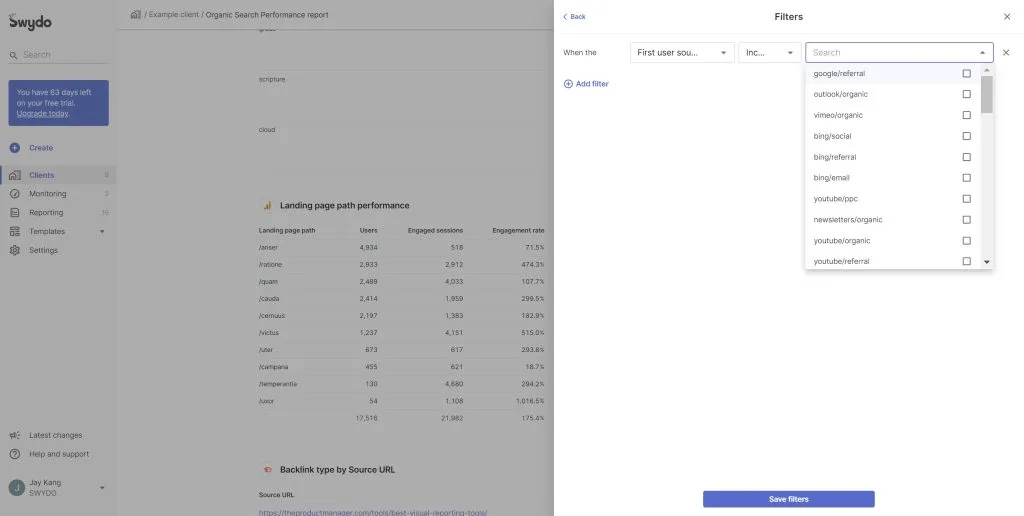
With Swydo’s integration with GA4, you can import detailed organic traffic data directly into your reports. This integration allows you to analyze keyword performance, identify high-traffic pages, and understand what drives organic visitors to your client’s site.
Create Google Analytics segments for high-value organic traffic. Track visitors who view multiple pages, spend significant time on the site, or hit key conversion pages. These segments reveal the true quality of your SEO efforts over time.
Quality trumps quantity every time. A modest increase in highly relevant traffic often outperforms a large spike in untargeted visits. Your mission? Attract visitors primed for conversion, not just inflate traffic numbers.
Build client dashboards that go beyond basic traffic trends. Include engagement metrics like average engagement time per session, engaged sessions per user, and conversion events for organic visitors. This comprehensive view showcases the full impact of your SEO strategy.
Long-term trends tell the real story. While month-to-month fluctuations occur, focus on the bigger picture. Are you consistently growing organic traffic year over year? Are you capturing an increasing share of your client’s target market? These questions reveal the lasting value of your SEO work.
Organic traffic reflects your ability to align your client’s online presence with their audience’s needs and search behaviors. Master this alignment, and you’ll not only drive traffic but deliver tangible business results.
2. Conversion Rate from Organic Traffic
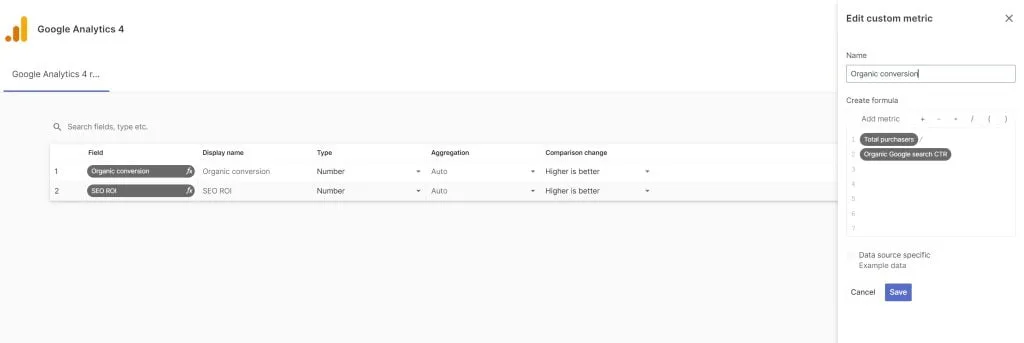
Conversion rate from organic traffic directly links your SEO efforts to your client’s bottom line. It’s the metric that transforms clicks into customers, visitors into valuable leads.
Calculate this rate by dividing the number of conversions from organic traffic by the total number of organic visitors, then multiply by 100. But don’t stop at the overall rate – segment it by landing page, traffic source, and user demographics to uncover hidden opportunities.
A high organic traffic conversion rate indicates you’re not just attracting visitors, but the right visitors. It shows you understand user intent and deliver content that matches what searchers are looking for.
Set up conversion tracking in Google Analytics to monitor both macro conversions (like purchases or form submissions) and micro conversions (like newsletter sign-ups or video views). This gives you a fuller picture of how organic visitors engage with your client’s site.
Compare your organic conversion rate to other traffic sources. If it’s significantly lower, you might need to reassess your keyword targeting or landing page optimization. If it’s higher, you’ve got a strong case for increasing your client’s SEO budget.
Don’t settle for average industry conversion rates. Push for continuous improvement. A/B test your landing pages, refine your calls-to-action, and optimize your site’s user experience. Even small improvements in conversion rate can lead to significant revenue increases for your clients.
Use conversion path reports to understand how organic traffic interacts with other channels before converting. This multi-touch attribution view helps you articulate the full value of your SEO efforts, especially for clients with longer sales cycles.
When reporting to clients, don’t just present the numbers. Tell the story of how your SEO work is driving real business results. Show them the revenue impact of their improved organic conversion rate. This tangible connection between SEO and business growth will cement your value as a strategic partner.
3. Keyword Rankings for Strategic Terms
Keyword rankings remain a crucial indicator of your SEO success. While they’re not the end-all-be-all, they provide valuable insights into your visibility for important searches in your client’s niche.
Focus on tracking a mix of short-tail and long-tail keywords that align with different stages of the customer journey. This approach gives you a comprehensive view of your client’s search presence across various user intents.
Don’t get hung up on chasing #1 rankings for every keyword. Instead, prioritize terms that drive valuable traffic and conversions. A #3 ranking for a high-intent, transactional keyword often delivers more value than a #1 ranking for a low-intent informational term.
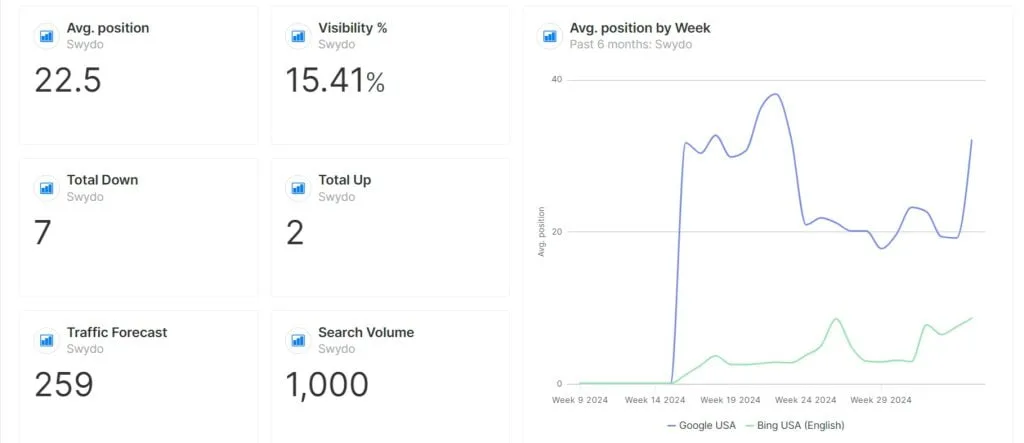
Use tools like Semrush or SE Ranking to monitor your rankings daily. Look for trends and sudden changes that might indicate algorithm updates or increased competition. Quickly identifying ranking drops allows you to react swiftly and minimize potential traffic losses. SE Ranking can even help you identify traffic forecasting opportunities.
Pay attention to SERP features like featured snippets, local packs, and image carousels. Optimizing for these can significantly increase your client’s visibility, even if you’re not in the #1 organic position.
When reporting rankings to clients, provide context. Explain how changes in rankings correlate with traffic and conversion metrics. This helps clients understand the real impact of ranking fluctuations on their business goals.
4. Core Web Vitals
Page speed is more than a ranking factor; it’s a key determinant of user experience and conversion rates. In an age of instant gratification, slow-loading pages can kill your SEO efforts before they even begin.
Use tools like Google PageSpeed Insights and Pingdom to measure and monitor your page speed regularly. Pay special attention to mobile page speed, as Google’s mobile-first indexing means this is now your primary battleground.
Don’t just look at the overall score. Dive into specific Core Web Vitals metrics like Interaction to Next Paint (INP), First Contentful Paint (FCP), and Largest Contentful Paint (LCP). These granular measurements help you pinpoint exactly where your site is lagging.
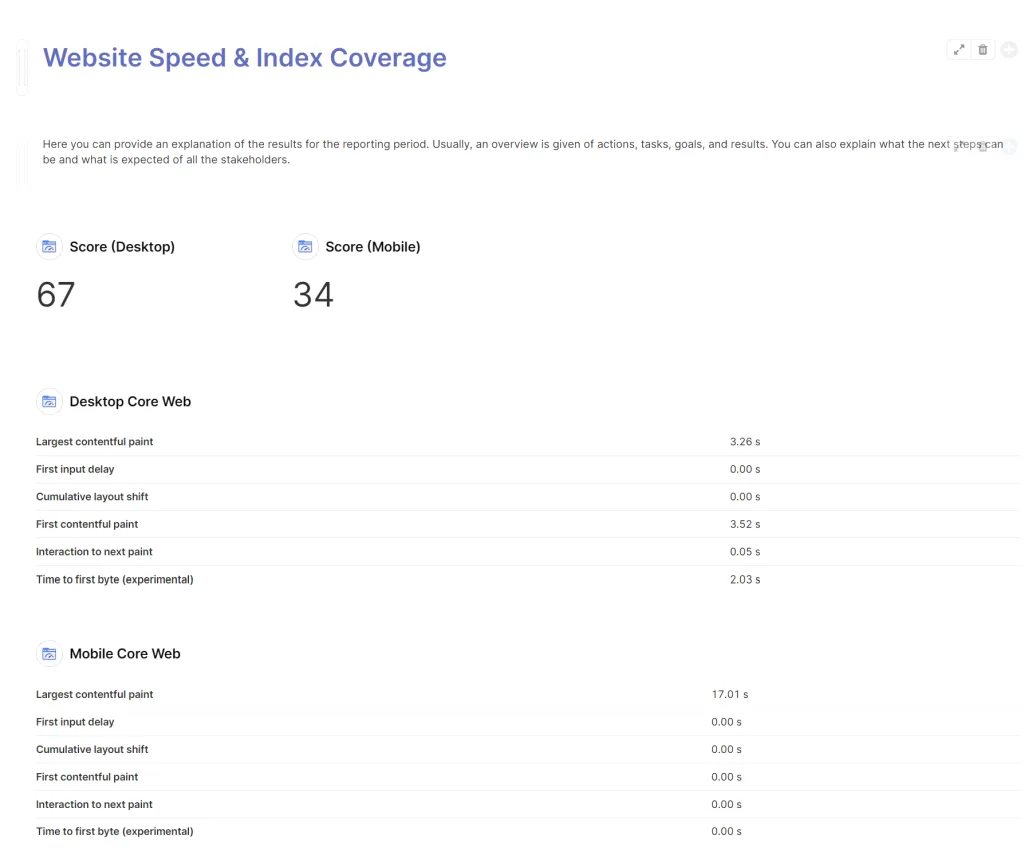
Prioritize speed improvements on your most important pages first. Your homepage, top landing pages, and key conversion pages should be lightning fast. Even small improvements here can lead to significant gains in traffic and conversions.
Use the mobile vs. desktop results to determine which device types might require more attention.
Implement easy wins like image optimization, browser caching, and minification of CSS and JavaScript files. Then move on to more complex optimizations like reducing server response time and leveraging browser caching.
Establish a baseline for each critical page, then monitor these metrics regularly to detect improvements or regressions. Perform a constant site audit, report on trends over weeks or months to show the long-term impact of any optimizations.
Don’t forget to test your speed improvements. Use A/B testing to measure the impact of speed enhancements on user engagement and conversion rates. This data helps you prove the ROI of technical SEO work to your clients.
5. Organic Click-Through Rate (CTR)
Organic CTR reveals how compelling your search listings are compared to your competitors. A high CTR indicates that your titles and meta descriptions are effectively enticing users to click through to your site.
Monitor your CTR in Google Search Console, paying attention to how it varies across different queries and pages. Typically, the top positions get higher CTR, but variations can indicate issues with your snippets.
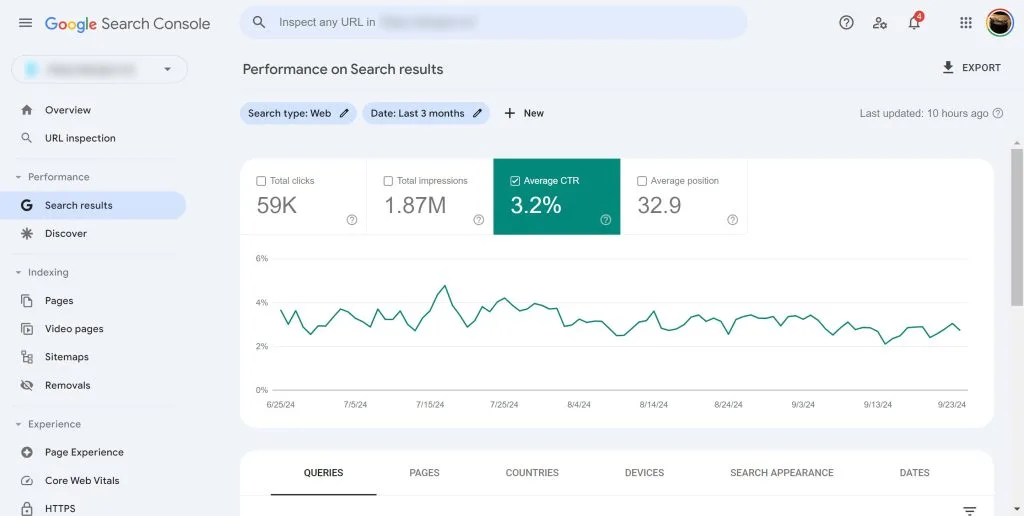
While Google Analytics doesn’t directly report on CTR, you can set up a custom dashboard that combines Search Console data with other engagement metrics, such as bounce rate and session duration, to get a fuller picture of how users interact with your site after clicking through from search results.
Don’t ignore the impact of rich snippets on CTR. Implement structured data markup to enhance your SERP appearance with stars, prices, or other relevant information that can make your listing stand out.
Track your CTR over time and in relation to ranking changes. Sometimes, moving up just one position can dramatically improve your CTR. Use this data to prioritize your ranking improvement efforts.
Average CTR by the way, varies by position and industry. Benchmark your performance against industry standards, but always strive to beat the average for your specific niche.
6. Backlink Quality and Quantity
Backlinks remain a cornerstone of SEO, signaling to search engines that other reputable sites vouch for your content. But today, it’s all about quality over quantity.
Use tools like Semrush or Majestic to monitor your backlink profile. Track not just the number of backlinks, but their quality, relevance, and authority. A few links from highly respected sites in your industry can outweigh hundreds of low-quality links.
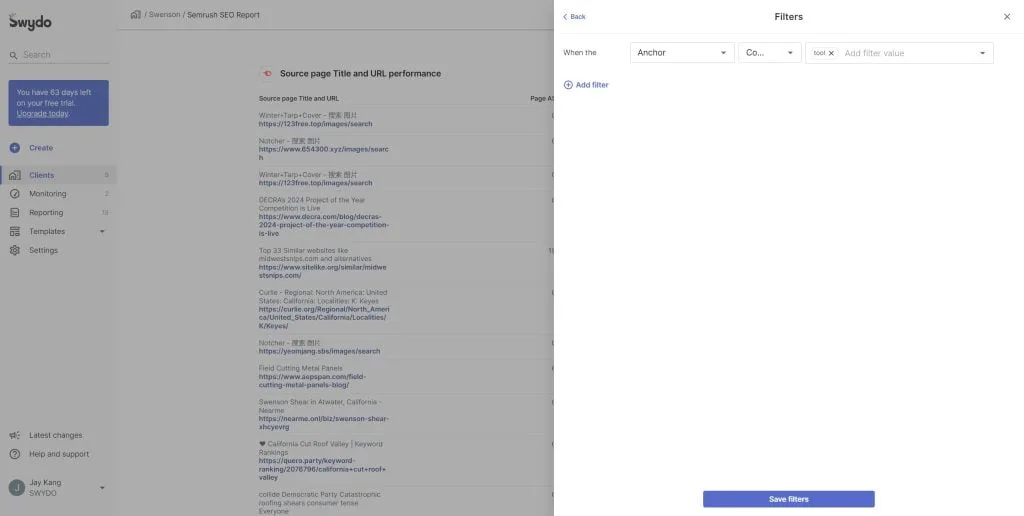
Monitor your link acquisition rate (link velocity) in tools like Semrush. A steady growth in backlinks is ideal, as it indicates natural, sustainable link-building practices. Sudden spikes in backlink acquisition could be flagged as suspicious by search engines, so it’s crucial to track this metric over time.
Analyze the anchor text distribution in your backlink profile. See which keywords are used as anchor text most frequently. Ensure a healthy mix of branded, naked URL, and keyword-rich anchor texts.
Don’t neglect link reclamation. Use tools to monitor for broken backlinks or mentions of your brand that aren’t linked. Reaching out to fix these can be an easy win for improving your backlink profile.
Check for broken backlinks (links pointing to 404 pages on your site) and reclaim them by creating a 301 redirect to a relevant page or by asking the linking site to update the URL.
Audit your backlink profile for toxic links. While Google’s gotten better at ignoring bad links, a high number of spammy backlinks can still hurt your SEO. Use Google’s Disavow Tool as a last resort for links you can’t get removed.
7. Domain Authority and Comparable Metrics
While not an official Google metric, domain strength metrics like Domain Authority (DA) from Moz, Domain Rating (DR) from Ahrefs, and Authority Score from Semrush provide a snapshot of your site’s overall SEO health and ranking potential. These metrics are particularly useful for competitive analysis and setting realistic ranking expectations.
Track your domain strength using tools like Semrush, Ahrefs, or Moz. Focus on long-term trends and significant changes rather than obsessing over minor fluctuations.
Compare your domain metric to your main competitors. This gives you insight into how challenging it might be to outrank them and helps you set realistic goals for your SEO campaigns.
Improve your domain authority or equivalent score by acquiring high-quality, relevant backlinks and creating authoritative content that naturally attracts links. Remember, these metrics are a reflection of good SEO practices, not an end goal.
Use these metrics to identify link-building opportunities. Sites with a slightly higher score than yours often make good targets for outreach and collaboration.
When reporting these metrics to clients, always provide context. Explain that while they are useful for understanding overall SEO progress, they are not direct ranking factors used by Google.
8. Mobile Traffic Percentage
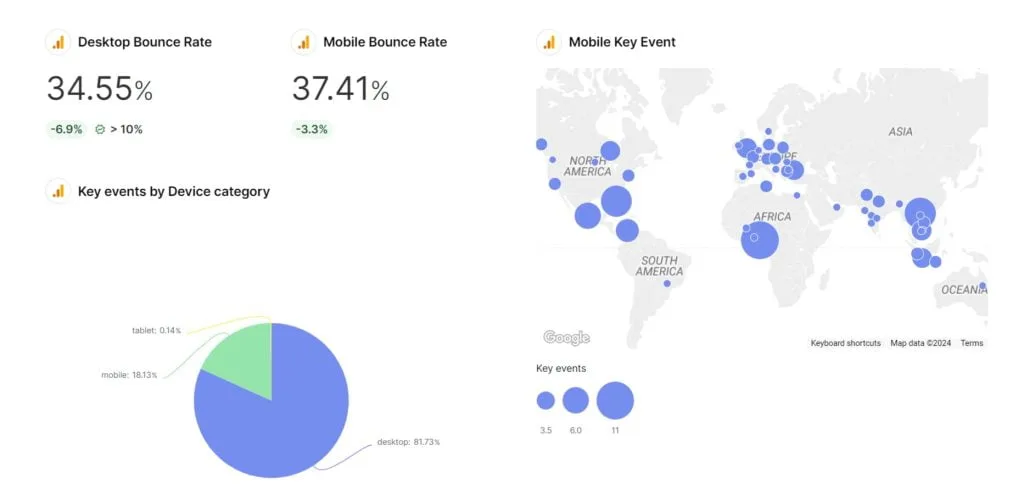
With Google’s mobile-first indexing, understanding and optimizing for your mobile audience is crucial. Your mobile performance can make or break your SEO efforts.
Use Google Analytics to track what percentage of your organic traffic comes from mobile devices. Look for trends over time – is your mobile traffic share growing?
Compare engagement metrics between mobile and desktop users. If mobile users have significantly higher bounce rates or lower conversion rates, you’ve got work to do on mobile optimization.
Pay attention to mobile-specific issues like touch-friendly navigation, readable font sizes, and properly sized tap targets. These factors significantly impact user experience and, consequently, your SEO performance.
Check individual pages. Don’t assume that because your site is responsive, it’s optimized for mobile. Each page needs to be checked and optimized.
9. Bounce Rate from Organic Traffic
Bounce rate can indicate whether your content meets user expectations and search intent. But be careful – a high bounce rate isn’t always bad.
While Bounce Rate is still an important metric, GA4 provides additional context through Engagement Rate, Engaged Sessions, and Average Engagement Time per Session. These metrics together offer a more complete picture of user behavior on your site.
Segment your bounce rate by traffic source, focusing on organic traffic. Compare it to your overall site average and to industry benchmarks.
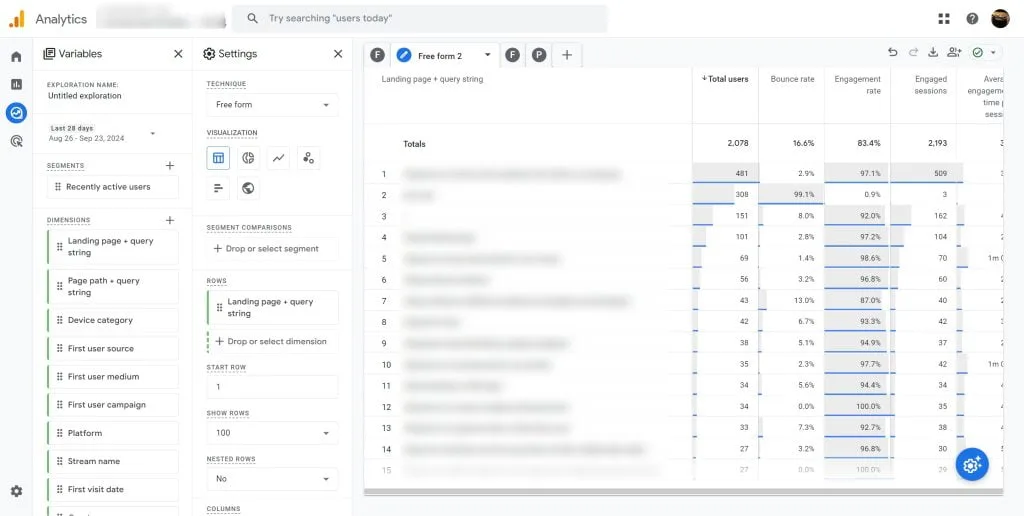
Understand how far users scroll on your pages. A high bounce rate coupled with low scroll depth might indicate that your content isn’t capturing attention or the page loads slowly.
Analyze bounce rates in context. For a blog post or informational page, a high bounce rate might mean users quickly found the information they needed. For a product page, it could signal a mismatch between user intent and page content.
Look for pages with unexpectedly high bounce rates. These are prime candidates for optimization. Check if the content matches the search intent, if the page loads quickly, and if the design encourages further exploration.
Use heatmapping tools like Hotjar to visualize how users interact with high-bounce pages. This can reveal usability issues that might be causing users to leave.
Compare your bounce rates to industry benchmarks for similar types of content. For example, blog posts typically have higher bounce rates than product pages, so context is crucial.
10. Return on Investment (ROI)
ROI is the ultimate metric for proving the value of your SEO services. It directly ties your efforts to your client’s bottom line.
Calculate SEO ROI by subtracting the cost of your services from the revenue generated through organic search, then dividing by the cost of your services. Multiply by 100 to get a percentage.
Work with your clients to assign accurate values to different types of conversions. This might include both direct revenue from e-commerce sales and estimated values for leads or other non-monetary conversions.
Use multi-touch attribution models to give SEO proper credit in the conversion process. Last-click attribution often undervalues SEO’s contribution, especially for businesses with longer sales cycles.
Track ROI over extended periods. SEO is a long-term strategy, and its full value often becomes apparent over months or years, not weeks.
Present ROI data alongside other metrics to tell a complete story. Show how improvements in rankings and traffic translate into real business value.
Don’t shy away from discussing ROI with your clients. It’s your strongest argument for retaining clients and justifying increased SEO budgets.
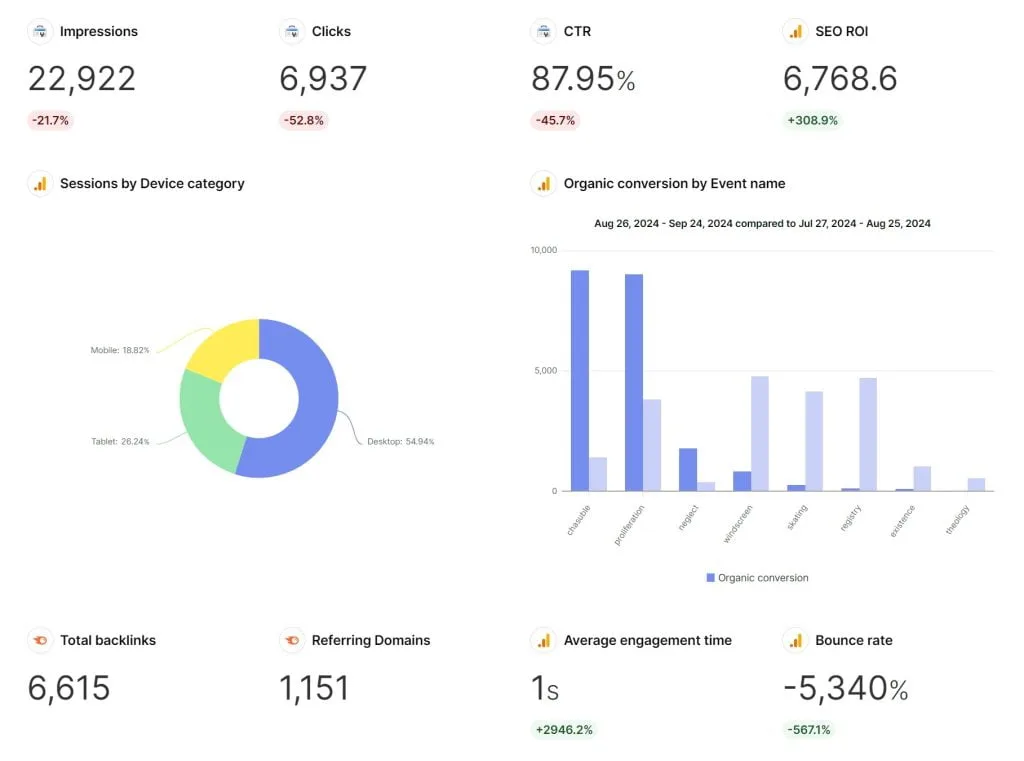
Bonus Metric – Branded Clicks
Both our data analysis and the top SEO metrics lists we’ve gathered missed one vital aspect that truly aligns with your client: branded keywords.
Branded organic clicks represent a crucial metric in digital marketing, serving as a barometer of a company’s online presence and reputation. These clicks occur when users search for a specific brand name or related terms and click on non-paid search results.
Unlike generic searches, branded queries indicate pre-existing awareness and interest in the company, often translating to higher conversion rates and customer loyalty.

We are noticing a trend where well-known brands are more likely to rank in the top 10 search results compared to lesser-known brands. Smaller affiliate sites are being overshadowed by authoritative sites like Forbes and others.
Building branded clicks is not about putting all your eggs in one basket, but rather a collaborative effort to strengthen your client’s website and brand perception. E-E-A-T (Experience, Expertise, Authoritativeness, and Trustworthiness) plays a critical role in this process. Focusing on E-E-A-T not only contributes to long-term success but also reduces reliance on Google alone. This means that even if Google’s algorithms change, your brand will still be sought out by users.
Correlate Google Search Console branded click data with Google Analytics direct homepage traffic to gain insights into your brand’s performance beyond Google search. Monitor competitor branded search performance to identify opportunities and benchmark your own progress.
Key Takeaway
- Focus on Impact: Prioritize metrics that directly influence client revenue and goals.
- Show the Value: Clearly demonstrate how your SEO efforts translate into business results.
- See the Big Picture: Combine multiple metrics to gain a comprehensive understanding of SEO performance.
- Personalize Your Strategy: Tailor your reporting and approach to each client’s unique needs.
Ultimately, the SEO metrics you choose to focus on will shape the effectiveness of your SEO efforts and the value you deliver to your clients. As you refine your approach, let these insights guide your decisions, ensuring that every report not only demonstrates results but also builds a stronger, more strategic partnership with those you serve. The right metrics are more than just numbers—they’re the key to unlocking meaningful growth and success.
Showcase your client’s SEO results with Swydo. Request a demo or sign up for a free 14-day trial today.
SEO Metrics FAQ
Direct answers to the most searched questions about SEO measurement and tracking
The 5 most important SEO metrics are: organic traffic, conversion rate from organic traffic, keyword rankings for target terms, organic click-through rate (CTR), and page load speed. These directly impact your bottom line and show real SEO performance.
SEO metrics are raw data points like bounce rate or keyword rankings. KPIs are metrics tied to specific business goals. For example, “organic traffic” is a metric, but “organic traffic conversion rate” is a KPI that shows business impact.
Check basic metrics weekly, but focus on monthly trends for decision-making. Daily checking can be misleading due to normal fluctuations. For client reporting, monthly reviews work best with quarterly deep dives for strategy adjustments.
A healthy organic traffic growth rate is 10-20% year-over-year for established sites. New sites can see 50-100%+ growth in the first year. Focus on quality traffic that converts rather than just total visitor numbers.
Organic CTR shows how compelling your search listings are. A higher CTR means more traffic without improving rankings. Average CTR varies by position: position 1 gets ~28%, position 3 gets ~11%, position 10 gets ~2%.
Essential free tools: Google Analytics 4, Google Search Console, and Google PageSpeed Insights. Popular paid tools include SEMrush, Ahrefs, and Moz for keyword tracking and competitive analysis. These cover 90% of SEO measurement needs.
Set up Goals or Events in GA4 for actions like form submissions, purchases, or downloads. Create a segment for “Organic Traffic” to isolate SEO performance. Calculate conversion rate by dividing organic conversions by organic sessions.
Google Search Console shows your average ranking positions for keywords that generate impressions. The Performance report displays queries, clicks, impressions, CTR, and average position. This is the most accurate free ranking data available.
Use tools like SEMrush, Ahrefs, or SimilarWeb to analyze competitor organic traffic, keyword rankings, and backlinks. Focus on keywords where you rank close to competitors (positions 4-10) for quick wins.
Use Google My Business Insights for local visibility metrics, Google Search Console for local keyword performance, and tools like BrightLocal or SEMrush for local ranking tracking. Monitor “near me” keywords and location-specific searches.
SEO ROI = (Revenue from Organic Traffic – SEO Costs) ÷ SEO Costs × 100. Track revenue using conversion tracking in Google Analytics. Assign values to leads for B2B businesses. Good SEO ROI is typically 300-500% or higher.
Average organic conversion rates range from 2-3% for e-commerce and 1-3% for lead generation. B2B sites often see 2-5%. However, focus on improving your baseline rather than industry averages, as conversion rates vary significantly by industry and business model.
Typically 3-6 months for meaningful results, with continued improvement over 12-18 months. Technical fixes can show results in weeks, while content and link building take longer. New sites need 6-12 months to establish authority.
Focus on business metrics: organic revenue, qualified leads from SEO, conversion rate improvements, and competitive ranking gains. Avoid vanity metrics like total keywords tracked. Show year-over-year growth and connect SEO performance to business goals.
E-commerce: Focus on revenue per organic session and product page rankings. B2B: Track qualified leads and download conversions. Local businesses: Monitor local pack rankings and “near me” visibility. SaaS: Measure trial signups and freemium conversions.
Core Web Vitals measure page experience: LCP (loading speed), INP (interactivity), and CLS (visual stability). They’re Google ranking factors and directly impact user experience. Good scores: LCP under 2.5s, INP under 200ms, CLS under 0.1.
Aim for under 3 seconds total load time, with 2.5 seconds or less for Largest Contentful Paint (LCP). Mobile speed is crucial since Google uses mobile-first indexing. Use Google PageSpeed Insights to check your scores and get improvement suggestions.
Use Google’s Mobile-Friendly Test tool or check the Mobile Usability report in Google Search Console. Also monitor mobile traffic percentage in Google Analytics – it should be 50%+ for most sites. Test your site on actual mobile devices regularly.
Bounce rates vary by content type. Blog posts: 70-90% can be normal. E-commerce: 20-45%. Landing pages: 70-90%. Focus on engagement metrics in GA4 like average engagement time and engaged sessions per user for better insights.
Quality matters more than quantity. A few high-authority, relevant backlinks outperform hundreds of low-quality links. Focus on earning links from reputable sites in your industry. Monitor your backlink profile using tools like Ahrefs or SEMrush.
Domain Authority (DA) is Moz’s 1-100 score predicting ranking ability. While not a Google ranking factor, it’s useful for competitive analysis. Focus on improving factors that increase DA: quality backlinks, good content, and technical SEO.
Monitor daily organic traffic, keyword ranking changes, and click-through rates during update periods. Use tools like SEMrush Sensor or Mozcast to track algorithm volatility. Focus on content quality and user experience to weather updates better.
Organic search visibility estimates what percentage of clicks you could get for your tracked keywords based on rankings. It’s calculated using keyword search volume, ranking positions, and estimated CTR. Tools like SEMrush and Sistrix provide visibility scores.
Track organic traffic by page, average time on page, scroll depth, and social shares. Use Google Search Console to see which content ranks for valuable keywords. Monitor featured snippet captures and “People Also Ask” appearances for content reach.
SERP features include featured snippets, image packs, local packs, and knowledge panels. Track them using SEMrush, Ahrefs, or Search Console. Featured snippets can increase CTR significantly even from lower positions. Optimize content structure for snippet capture.
Monitor long-tail question keywords and featured snippet captures, as voice searches often pull from these. Track conversational keywords and “near me” searches. Use Google Search Console to identify question-based queries driving traffic to your site.
Track the SEO metrics that matter and prove your agency’s value to clients with precision.
Start Your Free Trial Today